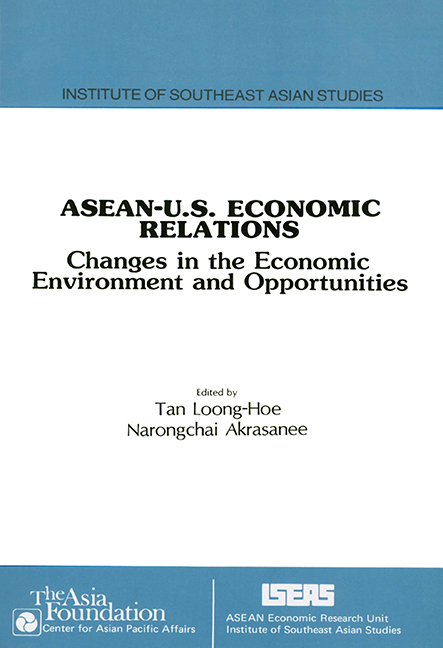Book contents
- Frontmatter
- Contents
- List of Tables
- List of Figures
- Foreword
- Changes in the ASEAN-U.S. Economic Environment and Opportunities: An Introductory Overview
- PART I ECONOMIC TRENDS
- 1 Economic Trends in the United States and Their Implications for ASEAN
- 2 Increasing Protectionism and Its Implications for ASEAN-U.S. Economic Relations
- PART II STRUCTURAL ADJUSTMENTS
- PART III TRADE IN SERVICES
- PART IV ROLE OF PRIVATE SECTOR
- THE EDITORS
1 - Economic Trends in the United States and Their Implications for ASEAN
from PART I - ECONOMIC TRENDS
Published online by Cambridge University Press: 21 October 2015
- Frontmatter
- Contents
- List of Tables
- List of Figures
- Foreword
- Changes in the ASEAN-U.S. Economic Environment and Opportunities: An Introductory Overview
- PART I ECONOMIC TRENDS
- 1 Economic Trends in the United States and Their Implications for ASEAN
- 2 Increasing Protectionism and Its Implications for ASEAN-U.S. Economic Relations
- PART II STRUCTURAL ADJUSTMENTS
- PART III TRADE IN SERVICES
- PART IV ROLE OF PRIVATE SECTOR
- THE EDITORS
Summary
It was long thought that although other countries were dependent on the world economy, the United States was not. This clearly is no longer true, and in fact, may never have been true to the degree generally believed. In the future, the United States will be prosperous only to the extent that it can earn its way in world markets. If the world economy can make rapid progress, then the United States will do quite well. However, if the world economy is in the midst of a period of slow growth — as seems to be the case — then the U.S. economy will be lethargic.
The crucial dependence of the United States on the world economy was recognized for policy purposes and formalized by the Group of Five (G-5) industrial countries at their meeting on 22 September 1985. Indeed, that meeting at the Plaza Hotel in New York was of such importance as to mark a change in the international monetary system. It was agreed that the U.S. dollar should depreciate in value, in particular against the Japanese yen and German deutschmark. The importance of that agreement comes from the recognition that the United States could not make economic progress with an overvalued dollar, and that depreciating the dollar could be better accomplished by international co-operation than by the United States acting on its own.
Efforts to improve macro-economic co-ordination were carried a step further at the Tokyo Economic Summit in 1986. While actual co-ordination was not accomplished, the mere consideration of mechanisms to help bring this about was an advance. The implication of this mechanism for all countries, and ASEAN in particular, will be noted subsequently.
Econometric models of the U.S. economy indicate that the outlook for 1986-87 is for GNP to grow at a rate of about 2.5 per cent. Since 2.5 per cent is also believed to be the rate of growth of potential income in the United States, the short-and the medium-term growth paths are seen to correspond.
- Type
- Chapter
- Information
- ASEAN-U.S. Economic RelationsChanges in the Economic Environment and Opportunities, pp. 3 - 23Publisher: ISEAS–Yusof Ishak InstitutePrint publication year: 1988

